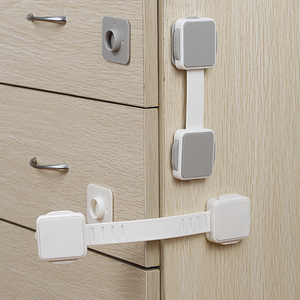
All categories
Featured selections
Trade Assurance
Buyer Central
Help Center
Get the app
Become a supplier

(39506 products available)














































In the realm of furniture design and manufacturing, securing mechanisms play a pivotal role in ensuring both functionality and security. Among these mechanisms, cabinet and drawer locks have become indispensable components. Designed to provide safety and security for various furniture pieces, these locks are engineered to meet diverse needs, from simple drawer locks to complex cabinet locking systems. The versatility and adaptability of cabinet and drawer locks make them essential for both residential and commercial furniture applications, where protection of contents and prevention of unauthorized access are paramount.
The range of cabinet and drawer locks available is vast, catering to different furniture designs and security requirements. Common types include cam locks, deadbolts, and electronic locks. Cam locks are often used in cabinets and drawers, providing a straightforward locking mechanism that is easy to operate. Deadbolts offer higher security and are typically found in more robust furniture pieces, such as wardrobes and storage units. Electronic locks, incorporating advanced technology, are becoming increasingly popular for modern furniture, offering programmable access and enhanced security features. Each type of cabinet and drawer locks is designed to fulfill specific security needs, ensuring that the furniture remains both functional and secure.
cabinet and drawer locks serve multiple functions, primarily centered around securing furniture contents and enhancing user safety. They act as deterrents against unauthorized access, protecting valuable items stored within furniture pieces. Features such as key-operated systems, combination mechanisms, and electronic access enhance convenience and usability. Key-operated systems provide simplicity and reliability, while combination mechanisms offer user-specific security options. Electronic access, often found in high-end furniture, allows for remote operation and monitoring. The integration of cabinet and drawer locks into furniture design not only ensures security but also contributes to the aesthetic appeal, with locks available in various finishes and styles to complement the furniture.
The construction of cabinet and drawer locks involves a combination of robust materials and precision engineering. Typically, these locks are made from metals such as steel, brass, and zinc, chosen for their strength and durability. Steel provides high resistance to tampering and wear, making it ideal for heavy-duty applications. Brass offers corrosion resistance and a classic appearance, suitable for decorative furniture pieces. Zinc is valued for its versatility and cost-effectiveness. Additionally, components such as tumblers, springs, and levers are meticulously crafted to ensure smooth operation and reliability. The choice of materials and components directly impacts the performance and longevity of cabinet and drawer locks, making them a crucial consideration in furniture design.
Selecting the right cabinet and drawer locks involves assessing the specific security needs and the type of furniture involved. Considerations include the level of security required, the ease of use, and compatibility with the furniture design. For high-security applications, electronic locks may be preferred, whereas cam locks might suffice for everyday use. Maintenance is equally important to ensure the longevity and effectiveness of cabinet and drawer locks. Regular cleaning of the lock mechanism, lubrication of moving parts, and inspection for wear and tear are essential practices. Proper maintenance not only extends the life of the lock but also enhances its functionality, providing continued security for the furniture.
When it comes to securing furniture, cabinet and drawer locks play an integral role in safeguarding contents and preventing unauthorized access. The choice of lock can significantly impact the security level, aesthetics, and functionality of the furniture piece. Different types of cabinet and drawer locks cater to varied needs, from simple mechanical locks to sophisticated electronic systems. Understanding the specific requirements of your furniture and the environment in which it will be used is crucial for selecting the appropriate lock. Factors such as ease of use, durability, and compatibility with the furniture design are essential considerations that can influence your decision.
Choosing the right cabinet and drawer locks involves several key considerations to ensure optimal security and functionality. The type of furniture and its intended use are primary factors; for instance, a cabinet in a high-traffic area may require a more robust locking system than a private drawer. The material of the lock is another important aspect, as it affects both the durability and appearance of the furniture. Metals like steel and brass offer strength and aesthetic appeal, while electronic locks provide advanced security features. Additionally, compatibility with existing furniture hardware and ease of installation should be evaluated to ensure seamless integration.
To enhance security, consider using cabinet and drawer locks with advanced features such as combination mechanisms or electronic access. These options offer increased protection against tampering and unauthorized entry. Regular maintenance, including cleaning and lubrication, can also ensure that locks function properly and remain secure over time.
Electronic cabinet and drawer locks are generally suitable for modern furniture designs, especially where high security is a priority. They offer programmable access and can be integrated into smart home systems. However, they may not be ideal for antique or decorative furniture due to aesthetic considerations.
Common materials used in cabinet and drawer locks include steel, brass, and zinc. Steel is favored for its strength and resistance to tampering, while brass offers a classic look and corrosion resistance. Zinc is often used for its cost-effectiveness and versatility in design.
Yes, cabinet and drawer locks can be customized in terms of finish and style to complement the design of your furniture. Many manufacturers offer options in various colors and textures to ensure that the lock matches the overall aesthetic of the furniture piece.
Maintaining cabinet and drawer locks involves regular cleaning and lubrication of moving parts to prevent wear and tear. It's also important to periodically inspect the lock for signs of damage or malfunction. Proper maintenance ensures that the lock remains functional and secure, extending its lifespan.